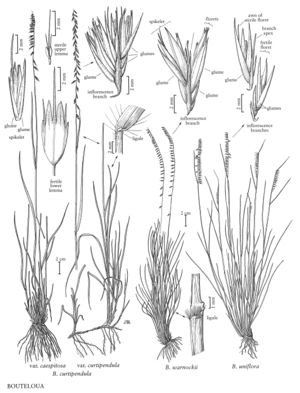Difference between revisions of "Bouteloua curtipendula var. curtipendula"
FNA>Volume Importer |
FNA>Volume Importer |
||
| Line 1: | Line 1: | ||
{{Treatment/ID | {{Treatment/ID | ||
|accepted_name=Bouteloua curtipendula var. curtipendula | |accepted_name=Bouteloua curtipendula var. curtipendula | ||
| − | |accepted_authority= | + | |accepted_authority= |
|publications= | |publications= | ||
|basionyms= | |basionyms= | ||
| Line 16: | Line 16: | ||
-->{{Treatment/Body | -->{{Treatment/Body | ||
|distribution=W.Va.;Alta.;B.C.;Man.;Ont.;Sask.;Ala.;Ariz.;Ga.;Ill.;Ind.;Ky.;Md.;Mich.;Minn.;Miss.;N.Dak.;Nebr.;N.J.;N.Mex.;N.Y.;Ohio;Pa.;S.Dak.;Tenn.;Utah;Wis.;Wyo.;Conn.;Idaho;Maine;S.C.;Fla.;Tex.;La.;Va.;Colo.;Ark.;D.C;Pacific Islands (Hawaii);Oreg.;Wash.;Iowa;Kans.;Okla.;Mo.;Mont. | |distribution=W.Va.;Alta.;B.C.;Man.;Ont.;Sask.;Ala.;Ariz.;Ga.;Ill.;Ind.;Ky.;Md.;Mich.;Minn.;Miss.;N.Dak.;Nebr.;N.J.;N.Mex.;N.Y.;Ohio;Pa.;S.Dak.;Tenn.;Utah;Wis.;Wyo.;Conn.;Idaho;Maine;S.C.;Fla.;Tex.;La.;Va.;Colo.;Ark.;D.C;Pacific Islands (Hawaii);Oreg.;Wash.;Iowa;Kans.;Okla.;Mo.;Mont. | ||
| − | |discussion=<p>Bouteloua curtipendula var. curtipendula is the common variety of B. curtipendula in most of the Flora region. It grows on rich, loamy, well-drained prairie soils. Its elevational range extends from below 100 m to 2500 m.</p> | + | |discussion=<p><i>Bouteloua curtipendula </i>var.<i> curtipendula</i> is the common variety of <i>B. curtipendula</i> in most of the Flora region. It grows on rich, loamy, well-drained prairie soils. Its elevational range extends from below 100 m to 2500 m.</p> |
|tables= | |tables= | ||
|references= | |references= | ||
| Line 25: | Line 25: | ||
-->{{#Taxon: | -->{{#Taxon: | ||
name=Bouteloua curtipendula var. curtipendula | name=Bouteloua curtipendula var. curtipendula | ||
| − | + | |authority= | |
| − | |authority= | ||
|rank=variety | |rank=variety | ||
|parent rank=species | |parent rank=species | ||
| Line 32: | Line 31: | ||
|basionyms= | |basionyms= | ||
|family=Poaceae | |family=Poaceae | ||
| − | |illustrator=Linda A. Vorobik | + | |illustrator=Linda A. Vorobik;Cindy Roché |
| + | |illustration copyright=Utah State University | ||
|distribution=W.Va.;Alta.;B.C.;Man.;Ont.;Sask.;Ala.;Ariz.;Ga.;Ill.;Ind.;Ky.;Md.;Mich.;Minn.;Miss.;N.Dak.;Nebr.;N.J.;N.Mex.;N.Y.;Ohio;Pa.;S.Dak.;Tenn.;Utah;Wis.;Wyo.;Conn.;Idaho;Maine;S.C.;Fla.;Tex.;La.;Va.;Colo.;Ark.;D.C;Pacific Islands (Hawaii);Oreg.;Wash.;Iowa;Kans.;Okla.;Mo.;Mont. | |distribution=W.Va.;Alta.;B.C.;Man.;Ont.;Sask.;Ala.;Ariz.;Ga.;Ill.;Ind.;Ky.;Md.;Mich.;Minn.;Miss.;N.Dak.;Nebr.;N.J.;N.Mex.;N.Y.;Ohio;Pa.;S.Dak.;Tenn.;Utah;Wis.;Wyo.;Conn.;Idaho;Maine;S.C.;Fla.;Tex.;La.;Va.;Colo.;Ark.;D.C;Pacific Islands (Hawaii);Oreg.;Wash.;Iowa;Kans.;Okla.;Mo.;Mont. | ||
|reference=None | |reference=None | ||
| Line 38: | Line 38: | ||
|publication year= | |publication year= | ||
|special status= | |special status= | ||
| − | |source xml=https:// | + | |source xml=https://jpend@bitbucket.org/aafc-mbb/fna-data-curation.git/src/f50eec43f223ca0e34566be0b046453a0960e173/coarse_grained_fna_xml/V25/V25_870.xml |
|subfamily=Poaceae subfam. Chloridoideae | |subfamily=Poaceae subfam. Chloridoideae | ||
|tribe=Poaceae tribe Cynodonteae | |tribe=Poaceae tribe Cynodonteae | ||
Revision as of 20:38, 16 December 2019
Plants not cespitose, with long rhizomes. Culms solitary or in small clumps. Blades 3-7 mm, flat. Panicles with 40-70 branches, averaging 3-7 spikelets per branch. Glumes and lemmas typically purple or purple-tinged; anthers red or red-orange, infrequently yellow, orange, or purple. 2n = 40, 41-66.
Distribution
W.Va., Alta., B.C., Man., Ont., Sask., Ala., Ariz., Ga., Ill., Ind., Ky., Md., Mich., Minn., Miss., N.Dak., Nebr., N.J., N.Mex., N.Y., Ohio, Pa., S.Dak., Tenn., Utah, Wis., Wyo., Conn., Idaho, Maine, S.C., Fla., Tex., La., Va., Colo., Ark., D.C, Pacific Islands (Hawaii), Oreg., Wash., Iowa, Kans., Okla., Mo., Mont.
Discussion
Bouteloua curtipendula var. curtipendula is the common variety of B. curtipendula in most of the Flora region. It grows on rich, loamy, well-drained prairie soils. Its elevational range extends from below 100 m to 2500 m.
Selected References
None.
